Obama: African-American museum helps tell fuller story of America
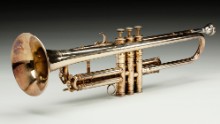
Photos: Smithsonian National Museum of African American History and Culture
Musical Crossroads – Internationally
renowned musician Louis Armstrong owned this 1946 Henri Selmer B-flat
trumpet, which was custom-made and inscribed for him by the Selmer
Company.
Hide Caption
11 of 20
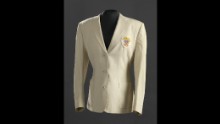
Photos: Smithsonian National Museum of African American History and Culture
Sports: Leveling the Playing Field – Tennis
great Althea Gibson was the first African-American woman to win a
Wimbledon tennis championship. The museum has many Gibson items,
including this U.S. Tennis Association wool blazer from the 1957
Wightman Cup, which Gibson won.
Hide Caption
12 of 20
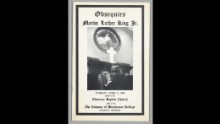
Photos: Smithsonian National Museum of African American History and Culture
A Changing America: 1968 and Beyond – A
16-page program for the April 9, 1968, funeral service for Martin
Luther King, Jr., at Ebenezer Baptist Church in Atlanta was stored in a
cloth clamshell box with a leather label.
Hide Caption
13 of 20
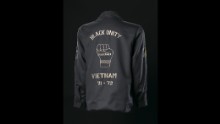
Photos: Smithsonian National Museum of African American History and Culture
A Changing America: 1968 and Beyond – American
soldiers fighting in Vietnam would often buy Vietnam tour jackets, and
black soldiers' jackets often had an embroidered message about black
unity and black power.
Hide Caption
14 of 20
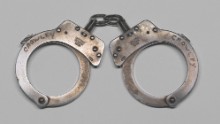
Photos: Smithsonian National Museum of African American History and Culture
A Changing America: 1968 and Beyond – These handcuffs were used in the 2009 arrest of
Harvard University professor Henry Louis Gates, Jr., in front of his
home in Cambridge, Massachusetts. Gates donated the handcuffs to the
museum.
Hide Caption
15 of 20
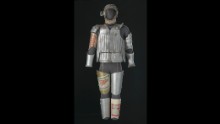
Photos: Smithsonian National Museum of African American History and Culture
Taking the Stage – This
costume for the Tin Man in the Broadway production of "The Wiz," an
African-American take on "The Wizard of Oz," is from 1975.
Hide Caption
16 of 20
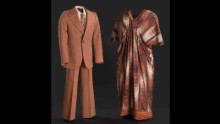
Photos: Smithsonian National Museum of African American History and Culture
Taking the Stage – Actor
Sherman Hemsley and actress Isabel Sanford wore these clothes when they
played married couple George and Louise Jefferson on the breakthrough
television series "The Jeffersons," which ran from 1975-85.
Hide Caption
17 of 20
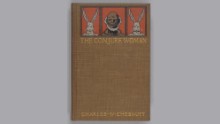
Photos: Smithsonian National Museum of African American History and Culture
Cultural Expressions – Charles
W. Chesnutt 's "Conjure Woman" was first published by Houghton Mifflin
Harcourt in 1899 and is considered an iconic work of African-American
literature of the time.
Hide Caption
18 of 20
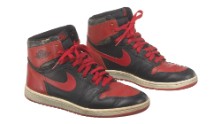
Photos: Smithsonian National Museum of African American History and Culture
Cultural Expressions – Basketball
star Michael Jordan made his Nike Air Jordan shoes a hot commodity.
This pair of size 13 red and black Air Jordan I high top sneakers is
from 1985, a year after he starting playing for the Chicago Bulls.
Hide Caption
19 of 20
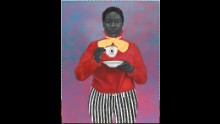
Photos: Smithsonian National Museum of African American History and Culture
Visual Arts and the American Experience – In "Grand Dame Queenie," her 2012 oil painting, contemporary artist Amy Sherald
explored themes of race, gender and identity. Born in Columbus,
Georgia, and now living in Baltimore, Sherald's work is also in National
Museum of Women in the Arts.
Hide Caption
20 of 20
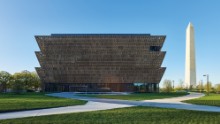
Photos: Smithsonian National Museum of African American History and Culture
Opening day – The Smithsonian's National Museum of African American History and Culture
in Washington opens on September 24, after a dedication ceremony with
President Barack Obama. The winning building design was by Freelon
Adjaye Bond/Smithgroup, a four-firm team. It was built on the last
available land on the National Mall.
Hide Caption
1 of 20
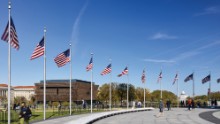
Photos: Smithsonian National Museum of African American History and Culture
A collection of the ordinary and extraordinary – The
museum's 12 inaugural exhibitions are organized around themes of
history, community and culture. One traces the history of the design and
building of the museum. Click through the gallery to see a sampling of
the 11 other installations.
Hide Caption
2 of 20
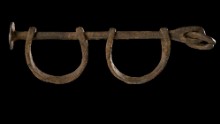
Photos: Smithsonian National Museum of African American History and Culture
Slavery and Freedom – The
story begins below ground in the museum's "Slavery and Freedom"
exhibit, which starts with the 15th-century transatlantic slave trade
and takes visitors through the Civil War and the Emancipation
Proclamation. These are pre-1860s shackles.
Hide Caption
3 of 20
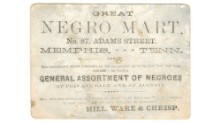
Photos: Smithsonian National Museum of African American History and Culture
Slavery and Freedom – This advertisement card promoted a slave sale in Memphis, Tennessee, circa 1859-1860.
Hide Caption
4 of 20

Photos: Smithsonian National Museum of African American History and Culture
Power of Place – African-American
farmer Joshua Lyles moved from Tennessee to Indiana in the 1840s and
founded a small town, Lyles Station, Indiana, where free
African-American farmers could live and farm. Lyles used this walking
plow, which was donated to the museum by Lyles Station Historic
Preservation Corporation. A few descendants of the town's original
occupants still farm the land there.
Hide Caption
5 of 20
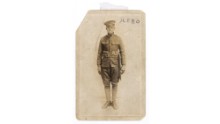
Photos: Smithsonian National Museum of African American History and Culture
Double Victory: The African American Military Experience – Lawrence
McVey, shown in uniform in this photographic postcard around 1914-18,
was part of the 369th United States Infantry, nicknamed the "Harlem
Hellfighters." They were the first African-American regiment of troops
to reach the battlefields of World War I, but they were assigned to the
French Army because of racial tensions among US troops. McVery was
awarded the Croix de Guerre by the French government for his bravery in
combat.
Hide Caption
6 of 20

Photos: Smithsonian National Museum of African American History and Culture
Defending Freedom, Defining Freedom: Era of Segregation – This
vintage open-cockpit biplane, used at Alabama's renowned Tuskegee
Institute to train African-American pilots for Army Air Corps service
during World War II, is on display.
Hide Caption
7 of 20

Photos: Smithsonian National Museum of African American History and Culture
Making A Way Out of No Way – Photographer
James H. Wallace took this picture of a July 4, 1964, march in Chapel
Hill, North Carolina. It was donated to the museum by his son, James H.
Wallace, Jr.
Hide Caption
8 of 20
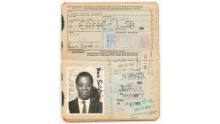
Photos: Smithsonian National Museum of African American History and Culture
Making a Way Out of No Way – Noted
author and playwright James Baldwin's U.S. passport, dated August 2,
1965, was donated to the museum by his family. It's one of many of
Baldwin's (1924-1987) personal effects given by his family to the
museum.
Hide Caption
9 of 20
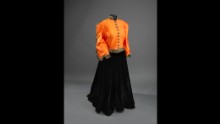
Photos: Smithsonian National Museum of African American History and Culture
Musical Crossroads – Singer
Marian Anderson made history when she sang at the Lincoln Memorial,
where first lady Eleanor Roosevelt invited her to perform after the
Daughters of the Revolution would not let her sing at Constitution Hall.
The skirt and decorative trim are original to the 1939 outfit. The rest
was added in 1993.
Hide Caption
10 of 20

Photos: Smithsonian National Museum of African American History and Culture
Musical Crossroads – Internationally
renowned musician Louis Armstrong owned this 1946 Henri Selmer B-flat
trumpet, which was custom-made and inscribed for him by the Selmer
Company.
Hide Caption
11 of 20

Photos: Smithsonian National Museum of African American History and Culture
Sports: Leveling the Playing Field – Tennis
great Althea Gibson was the first African-American woman to win a
Wimbledon tennis championship. The museum has many Gibson items,
including this U.S. Tennis Association wool blazer from the 1957
Wightman Cup, which Gibson won.
Hide Caption
12 of 20

Photos: Smithsonian National Museum of African American History and Culture
A Changing America: 1968 and Beyond – A
16-page program for the April 9, 1968, funeral service for Martin
Luther King, Jr., at Ebenezer Baptist Church in Atlanta was stored in a
cloth clamshell box with a leather label.
Hide Caption
13 of 20

Photos: Smithsonian National Museum of African American History and Culture
A Changing America: 1968 and Beyond – American
soldiers fighting in Vietnam would often buy Vietnam tour jackets, and
black soldiers' jackets often had an embroidered message about black
unity and black power.
Hide Caption
14 of 20

Photos: Smithsonian National Museum of African American History and Culture
A Changing America: 1968 and Beyond – These handcuffs were used in the 2009 arrest of
Harvard University professor Henry Louis Gates, Jr., in front of his
home in Cambridge, Massachusetts. Gates donated the handcuffs to the
museum.
Hide Caption
15 of 20

Photos: Smithsonian National Museum of African American History and Culture
Taking the Stage – This
costume for the Tin Man in the Broadway production of "The Wiz," an
African-American take on "The Wizard of Oz," is from 1975.
Hide Caption
16 of 20

Photos: Smithsonian National Museum of African American History and Culture
Taking the Stage – Actor
Sherman Hemsley and actress Isabel Sanford wore these clothes when they
played married couple George and Louise Jefferson on the breakthrough
television series "The Jeffersons," which ran from 1975-85.
Hide Caption
17 of 20

Photos: Smithsonian National Museum of African American History and Culture
Cultural Expressions – Charles
W. Chesnutt 's "Conjure Woman" was first published by Houghton Mifflin
Harcourt in 1899 and is considered an iconic work of African-American
literature of the time.
Hide Caption
18 of 20

Photos: Smithsonian National Museum of African American History and Culture
Cultural Expressions – Basketball
star Michael Jordan made his Nike Air Jordan shoes a hot commodity.
This pair of size 13 red and black Air Jordan I high top sneakers is
from 1985, a year after he starting playing for the Chicago Bulls.
Hide Caption
19 of 20

Photos: Smithsonian National Museum of African American History and Culture
Visual Arts and the American Experience – In "Grand Dame Queenie," her 2012 oil painting, contemporary artist Amy Sherald
explored themes of race, gender and identity. Born in Columbus,
Georgia, and now living in Baltimore, Sherald's work is also in National
Museum of Women in the Arts.
Hide Caption
20 of 20

Photos: Smithsonian National Museum of African American History and Culture
Opening day – The Smithsonian's National Museum of African American History and Culture
in Washington opens on September 24, after a dedication ceremony with
President Barack Obama. The winning building design was by Freelon
Adjaye Bond/Smithgroup, a four-firm team. It was built on the last
available land on the National Mall.
Hide Caption
1 of 20

Photos: Smithsonian National Museum of African American History and Culture
A collection of the ordinary and extraordinary – The
museum's 12 inaugural exhibitions are organized around themes of
history, community and culture. One traces the history of the design and
building of the museum. Click through the gallery to see a sampling of
the 11 other installations.
Hide Caption
2 of 20

Photos: Smithsonian National Museum of African American History and Culture
Slavery and Freedom – The
story begins below ground in the museum's "Slavery and Freedom"
exhibit, which starts with the 15th-century transatlantic slave trade
and takes visitors through the Civil War and the Emancipation
Proclamation. These are pre-1860s shackles.
Hide Caption
3 of 20

Photos: Smithsonian National Museum of African American History and Culture
Slavery and Freedom – This advertisement card promoted a slave sale in Memphis, Tennessee, circa 1859-1860.
Hide Caption
4 of 20

Photos: Smithsonian National Museum of African American History and Culture
Power of Place – African-American
farmer Joshua Lyles moved from Tennessee to Indiana in the 1840s and
founded a small town, Lyles Station, Indiana, where free
African-American farmers could live and farm. Lyles used this walking
plow, which was donated to the museum by Lyles Station Historic
Preservation Corporation. A few descendants of the town's original
occupants still farm the land there.
Hide Caption
5 of 20

Photos: Smithsonian National Museum of African American History and Culture
Double Victory: The African American Military Experience – Lawrence
McVey, shown in uniform in this photographic postcard around 1914-18,
was part of the 369th United States Infantry, nicknamed the "Harlem
Hellfighters." They were the first African-American regiment of troops
to reach the battlefields of World War I, but they were assigned to the
French Army because of racial tensions among US troops. McVery was
awarded the Croix de Guerre by the French government for his bravery in
combat.
Hide Caption
6 of 20

Photos: Smithsonian National Museum of African American History and Culture
Defending Freedom, Defining Freedom: Era of Segregation – This
vintage open-cockpit biplane, used at Alabama's renowned Tuskegee
Institute to train African-American pilots for Army Air Corps service
during World War II, is on display.
Hide Caption
7 of 20

Photos: Smithsonian National Museum of African American History and Culture
Making A Way Out of No Way – Photographer
James H. Wallace took this picture of a July 4, 1964, march in Chapel
Hill, North Carolina. It was donated to the museum by his son, James H.
Wallace, Jr.
Hide Caption
8 of 20

Photos: Smithsonian National Museum of African American History and Culture
Making a Way Out of No Way – Noted
author and playwright James Baldwin's U.S. passport, dated August 2,
1965, was donated to the museum by his family. It's one of many of
Baldwin's (1924-1987) personal effects given by his family to the
museum.
Hide Caption
9 of 20

Photos: Smithsonian National Museum of African American History and Culture
Musical Crossroads – Singer
Marian Anderson made history when she sang at the Lincoln Memorial,
where first lady Eleanor Roosevelt invited her to perform after the
Daughters of the Revolution would not let her sing at Constitution Hall.
The skirt and decorative trim are original to the 1939 outfit. The rest
was added in 1993.
Hide Caption
10 of 20
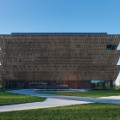
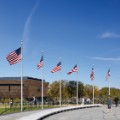
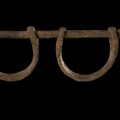
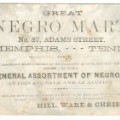

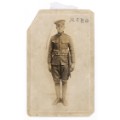

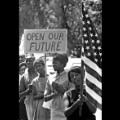
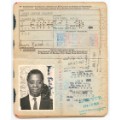
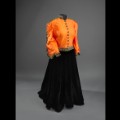
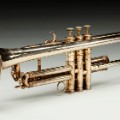
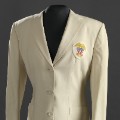
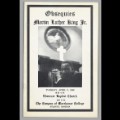
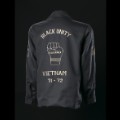
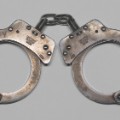
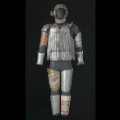
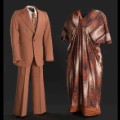
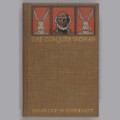
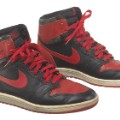
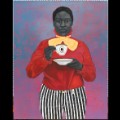
Story highlights
- "This national museum helps to tell a richer and fuller story of who we are," Obama said
- The museum's exhibit chronicling slavery and freedom is its centerpiece, officials say
Washington (CNN)President
Barack Obama said Saturday that the new Smithsonian museum devoted to
African-American history elevates the often-overlooked impact of black
Americans and will help others better understand the breadth of the
American story.
"This national
museum helps to tell a richer and fuller story of who we are," Obama,
the first African-American president, said at the National Museum of
African-American History and Culture.
"By
knowing this other story we better understand ourselves and each other.
It binds us together. It reaffirms that all of us are America, that
African-American history is not somehow separate from our larger
American story," he added. "It is central to the American story."
Saturday's
opening ceremony for the museum also was attended by civil rights icon
Rep. John Lewis, former Presidents George W. Bush and Bill Clinton and
Chief Justice John Roberts. Thousands are expected to have descended on
the National Mall this weekend to celebrate the museum's opening.
Calling
it an "act of patriotism" to understand African-American history and
the struggles of all Americans, Obama said "a great nation doesn't shy
away from the truth."
"We're
not a burden on America or a stain on America or an object of shame and
pity for America. We are America," Obama said. "And that's what this
museum explains."
"Hopefully, this museum makes us talk to each other and listen to each other and see each other," he added.
Obama
also said the museum can provide context to the current national debate
on the relationship between law enforcement and black communities that
recently made headlines following the police shooting deaths of black
men in Tulsa, Oklahoma, and Charlotte, North Carolina.
"Perhaps
it can help a white visitor understand the pain and anger of
demonstrators in places like Ferguson (Missouri) and Charlotte. But it
can also help black visitors appreciate the fact that not only is this
younger generation carrying on traditions of the past, but within the
white communities across the nation, we see the sincerity of law
enforcement officers and officials who, in fits and starts, are
struggling to understand and trying to do the right thing," he said.
"It
reminds us that routine discrimination and Jim Crow aren't ancient
history. It's just a blink in the eye of history," Obama continued.
Star-studded event
Saturday's
event included musical performances by Stevie Wonder, Patti LaBelle and
Denyce Graves, as well as appearances by Robert De Niro and Angela
Bassett, who read the words of black poets and historians.
The
effort to bring this museum to life began decades ago but was finally
set in motion in 2003 when Bush signed a bill creating it. Ground was
broken in February 2012.
The
Smithsonian says the museum is the only one in the US exclusively
focused on African-American life, history and culture, but organizers
say it is also meant to capture the story of all Americans.
One
of those who have worked for years to see this museum come to life is
educator and historian Lonnie Bunch, founding director for the museum.
Asked
what does it mean to him to see it finally open, he said, "It means
that finally the African-American story on the National Mall is
accessible to everybody, and in many ways it means that my ancestors are
smiling," he told CNN. "This is framed in a way that this is
everybody's story. It is not a black people's story. It is a story of
America."
Slavery and freedom at focus
Officials
said the chronicling of slavery and freedom are the centerpiece of the
museum. That exhibit contains such items as a slave cabin from South
Carolina, a bill of sale for a 16-year-old girl for $600, shackles used
on slaves and a copy of the Emancipation Proclamation.
There
is also an exhibition focusing on the fight against segregation, which
discusses the era from end of Reconstruction through the Civil Rights
Movement. Here, visitors see such things as abolitionist Harriet
Tubman's hymn book to a dress Rosa Parks was making shortly before she
was arrested for not giving up her seat on a segregated bus; a Tuskegee
airplane used to train African-American pilots for World War II flights;
a segregated Pullman train car as well as a stool from the Woolworth
store where there were sit-ins in Greensboro, North Carolina, in 1960;
and separate water fountains.
A
separate section examines the Civil Rights Movement, the Black Power
era of the 1960s and 1970s and other activism remembering many
activists, including Lewis and Dr. Martin Luther King.
The
museum holds more than 3,000 artifacts -- with many contributed from
ordinary Americans from across the country. There are also tens of
thousands of other artifacts which have been contributed which could be
rotated later into exhibition space.
There
are also many iconic items celebrating the achievements in sports,
music, television and film including Michael Jackson's fedora hat worn
during his 1984 "Victory Tour," boxer Muhammad Ali's headgear, musician
Chuck Berry's Cadillac, baseball star Jackie Robinson's bat, some of
Olympian Gabby Douglas' items as well as a statue honoring American
athletes who held their hands up as a demonstration of solidarity during
the 1968 Gold Medal ceremony.
Obama featured
One
exhibit honors the legacy of Obama's election. During an interview
airing Friday, he voiced his appreciation for all of those whose work
helped make the museum happen.
"We
were an outgrowth of Frederick Douglass and white abolitionists who
partnered with him," Obama told ABC News. "We were the consequence of
these Freedom Riders. Of all races. Young people idealistically coming
down here and being willing to challenge an unjust system."
Also
interesting is the design of the building. Sitting next to the
Washington Monument on the National Mall, the exterior is made up of
3,600 bronze-colored panels. The architects of the building drew on
imagery from both African and American history for the outer layer,
saying they were trying to reach towards the sky to express faith, hope
and resiliency. The building is three-tiered and is inspired by a
traditional wooden column that features a crown or corona -- or African
headdress -- at the top.
At night, the corona glows from the light within the building.

No comments:
Post a Comment